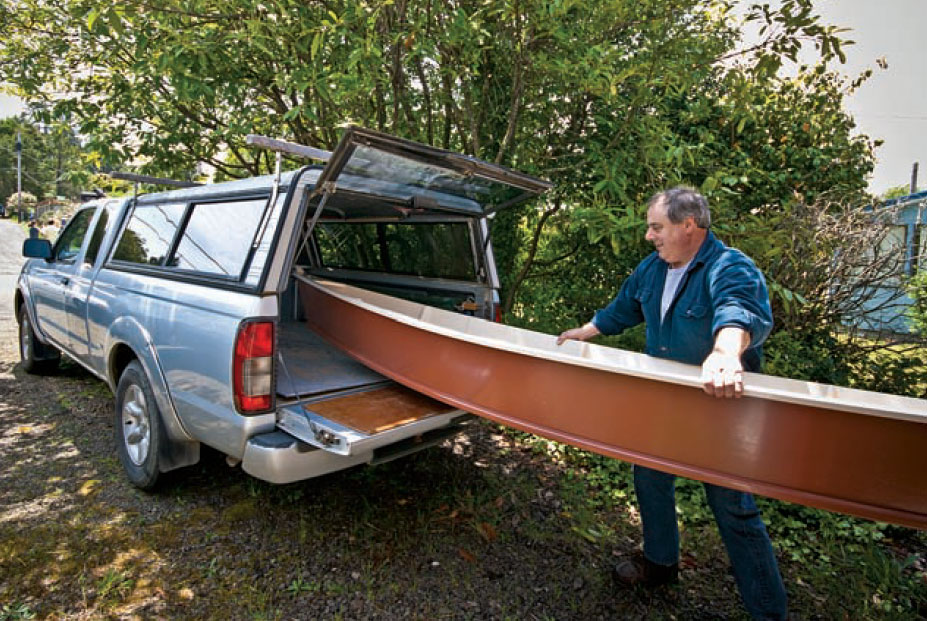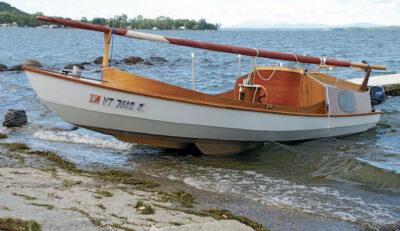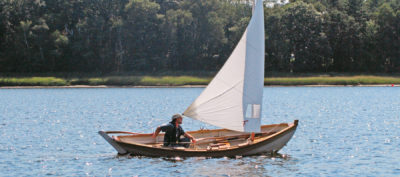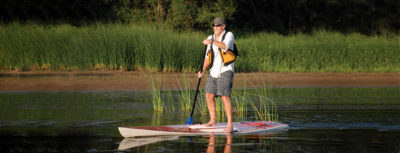 Warren Jordan
Warren JordanThis compact and easy-to-build canoe from designer Warren Jordan is a fine choice for a first-time builder who wants a lightweight craft for exploring shallow inlets, streams, and other calm waters.
Inexpensive, fun, and easy to build, this single-occupancy explorer canoe combines the sleek lines of a conventional canoe with the efficient paddling propulsion and minor draft constraints of a center-cockpit kayak. At 11′ 3″ LOA and 30″ beam and just under 40 lbs, NEWT is one of the handiest new canoes on the water.
Warren Jordan of South Beach, Oregon, designed NEWT with the desire to create a small craft that would not intimidate an inexperienced woodworker. He wanted her to be a size and weight that is easy to carry, able to accommodate a normal-sized adult, and still provide room for enough gear for a day trip. She loads and launches with ease: one can load NEWT on cartop roof racks or simply slide her into the back of a pickup, with the option of stacking two boats.
In addition to serving the individual builder, NEWT is a perfect fit for community boatbuilding workshops, where groups are usually looking to create a simple yet beautiful and useful craft in a short amount of time.
Warren Jordan is a man who refuses to let the sawdust settle. Most recognized for his cradle boat, Baby Tender, which he first designed and built in the late 1980s—a design that is still in demand—Jordan has since designed 25 other boats and has built over 50, all to a high professional standard.
 Warren Jordan
Warren Jordan“Marine plywood panels (1⁄4″ or 6mm thick) make up the sides, and then chine logs (long strips along the boat’s bottom) are attached to the outside of the hull. A plywood bottom will cap the assembly.”
I arranged to meet Jordan at his home. It was a moody spring Saturday, typical for the Oregon coast. In learning about him, I was immediately attracted to his ideal of no-waste wooden boat building. After deciding on a style of boat to design and build, he spends hours calculating how best to achieve the desired result with the hopes of leaving only sawdust on his shop floor as excess waste. With the growing awareness of the Earth’s limited natural resources, his minimalist approach to boatbuilding is gaining more widespread acceptance. Jordan said of NEWT, “If I have a sheet and a half of plywood, I try and get every piece of the boat out of that, including the paddles, with nothing left over, utilizing everything.” With a hull of plywood, paddle blades of plywood attached to an 8′ piece of closet rod, and remaining pieces that can be found at any local hardware store, NEWT runs about $200 in cost of materials.
After touring Warren’s modest and well-organized garage shop, snacking on treats prepared by his wife, Rita, and meeting their friends, Ashley and Yasmina, we set out for Ona Beach State Park for our trials. Ashley launched the boat; the rest of us walked along the shore, watching her as she glided effortlessly downstream. NEWT turned on a dime and seemed to react with ease. The water depth was no more than a few inches deep, yet Ashley kept her momentum. “You can paddle it in a puddle,” she said. That about sums it up.
 James Holzgraf
James HolzgrafWeighing less than 40 lbs, she is a cinch to carry in the back of a pickup truck or on top of almost any car.
Next, Yasmina had a turn. I decided to challenge her by putting her 50-lb chocolate Lab, Mojave, in the back to see if they could hold their balance. Mojave looked a little nervous, but nobody got wet and NEWT performed well under the added weight and altered load. But the real test of breaking strength came when I took my turn; I stand 6′ 8″ and weigh 230 lbs. I climbed in and shoved off, and NEWT took me gracefully along the bank. I was amazed at the boat’s stability as I paddled along. Even paddlers with significantly different body weights and proportions can enjoy a comfortable ride, mostly due to Jordan’s careful placement of the folding chair that is fixed amidships. This is an ordinary camp chair with adjustable reclining straps. The placement of the chair on the boat’s sole positions the paddler so that he or she can maneuver the double feathering paddle with ease. The chair doesn’t slide forward or aft because it is screwed to the ’midship frame and a shim that is mounted to the floor. A slight adjustment of the straps can give added com- fort and help to trim the boat. Until I felt NEWT in action I couldn’t fully appreciate the comfort that the seating arrangement offered. Even my legs—and I’m all legs—could rest fully extended rather than being bent. This allows for many more hours of comfortable cruising. For those who prefer a foot brace, the forward frame might suffice—or could be used to prop up a customized one.
 James Holzgraf
James HolzgrafWarren Jordan secured a camp seat just aft of center to place the paddler’s weight right where it will do the most good to keep the boat stable underway.
As mentioned earlier, NEWT’s flat-bottomed hull enables the user to maneuver her in a mere 8″–9″ of water. This makes her an optimum craft for paddling shallow estuaries and creeks. An ability to hold trim is essential for maintaining directional stability (the boat’s ability to track on course or to easily correct to get back on course). With every paddle stroke some sideways momentum accompanies forward movement. Without the correct amount of rocker (the longitudinal sweep of the boat’s bottom) and an accurate estimate of the location of the boat’s center of gravity, its efficiency would have been compromised. NEWT has no skeg, and her center of gravity is just aft of center; this adds just enough drag in the stern to preserve the desired directional stability.
The paddle blades are oriented on the loom at 90 degrees to one another. This keeps the non-working blade from facing the wind and slowing the boat while the stroke blade is underwater. To help prevent water from reaching the paddler as it drips inboard from the blades, Jordan has tied Turk’s Head knots a few inches inboard from each blade; this seems to do a good job of keeping both boat and paddler dry.
 James Holzgraf
James HolzgrafNEWT can carry a surprising variety of weights and loads without incident—even though Mojave the Lab seems a bit concerned.
Another advantage to the floor-seating arrangement is the increased level of intimacy with the waterway that it provides. For me, it conjures childhood memories of floating the rivers by raft and leaning over the edge—my nose just barely out of the water—wondering at the plants and rocks below as I make my way downstream. In a typical canoe, leaning over to touch the water or to grab something puts you at risk of capsizing. With NEWT, you feel less of that separation from the water. While a kayak brings you close to the water, NEWT makes you feel even closer because there is no deck fencing you in. This gives a whole new perspective and adds an important dimension to the experience, I think.
NEWT offers even the novice builder an empty canvas for experimentation and exploration. Once the basic boat is constructed, there is ample opportunity to outfit the boat to suit individual needs. With plenty of room for tie-down hooks, straps, or framing mounts for a cooler or gear bin, NEWT is spacious—and poised for fun.
Plans for Newt are available from Jordan Wood Boats, P.O. Box 194, South Beach, Oregon 97366, 541-867-3141.
 Warren Jordan
Warren JordanNEWT’s frames are set up on its modest strongback and are used to shape the hull. Every piece of the NEWT canoe is dimensioned, and many details—from breasthooks to paddle blades—are provided at full scale on the plans. Additionally, there are well-organized and thorough instructions on the plans to take you through every step of construction.














Join The Conversation
We welcome your comments about this article. If you’d like to include a photo or a video with your comment, please email the file or link.